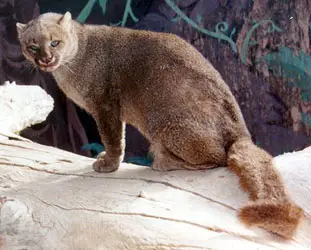The Jaguarundi (Puma yagouaroundi) is a species of cat found in North and South America. Because of the different color phases, people used to think that there were two different species: the grey one being called jaguarundi and the red one being called eyra.
Physical Features
The jaguarundi is a medium sized cat. In terms of physical appearance, it is the least cat-like of all felines and cats. It has a long body, short legs and a long tail which makes it look like a otter or sometimes a marten. As they look like an otter, they are sometimes called 'otter cats'. They do not have any spots on their body and their color is same throughout or sometimes it may have some faint markings on the underside and face. It has a total length of 54 to 74 cm out of which the tail is 32 to 52 cm long. It weighs about 4.2 kilograms to 10.3 kilograms. Jaguarundis can be brownish grey (grey phase) and foxy red to chestnut (red phase).
Behavior and Diet
Jaguarundis are mainly diurnal, being active during mornings. They normally hang around on trees but prefer hunting on ground. They will almost eat any animal they catch like rodents, small reptiles and even ground feeding birds. Jaguarundis may even eat larger pray like rabbits and some primates like marmosets, which is unusual for a wild cat. Like all cats, their diet consists of a small amount of vegetation of arthropods like scorpions. Jaguarundis are rather cordial than other wild cats. They can tolerate close presence of other animals. They are usually found alone as they lead a solitary life. Jaguarundis are shy and very cautious of man made traps.
Distribution and Habitat
 |
| Range of jaguarundis |
Conservation Status
Jaguarundis are not under any threat as of now. They are rated as 'Least Concern' by IUCN. They have a very wide range and therefore are not under threat.
Source of pic 1 and pic 2

No comments:
Post a Comment